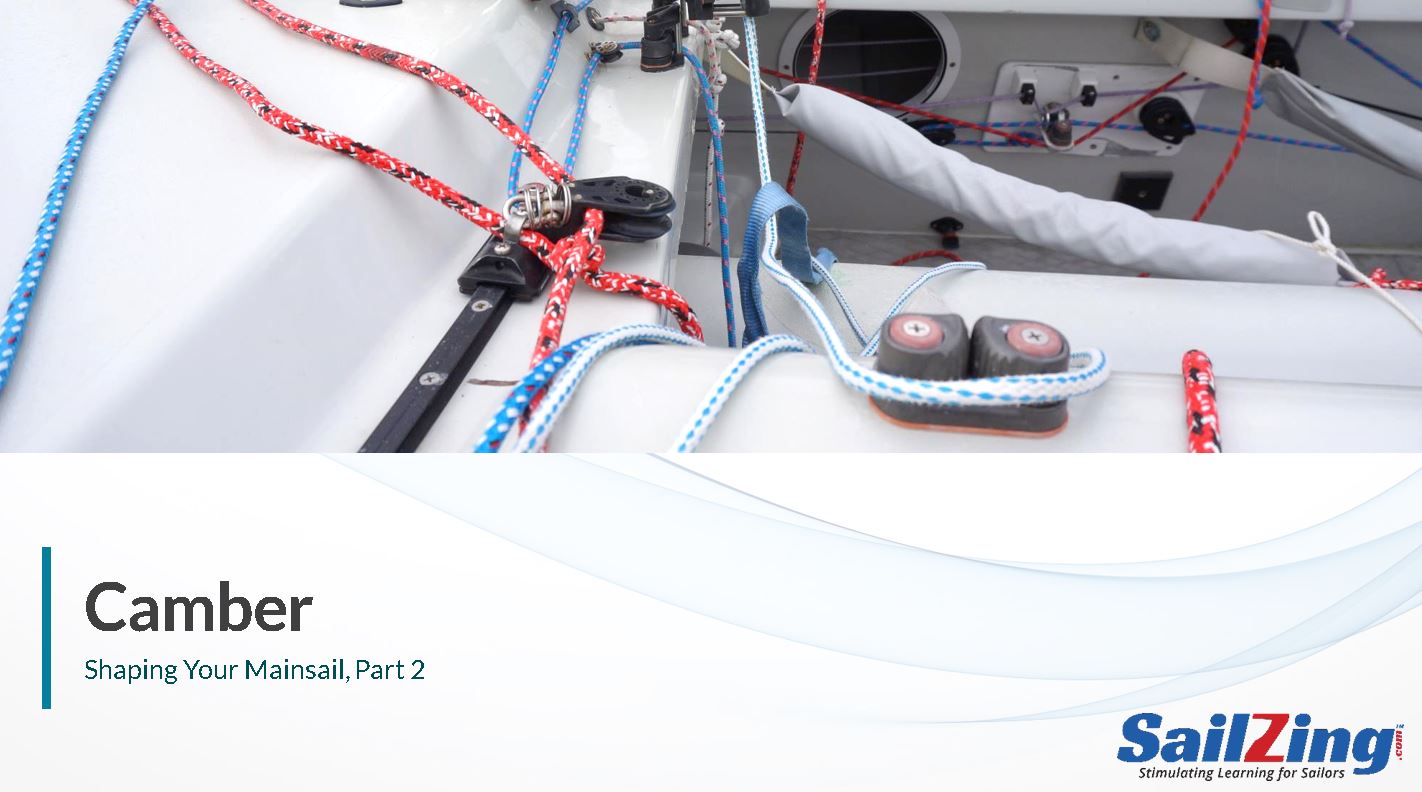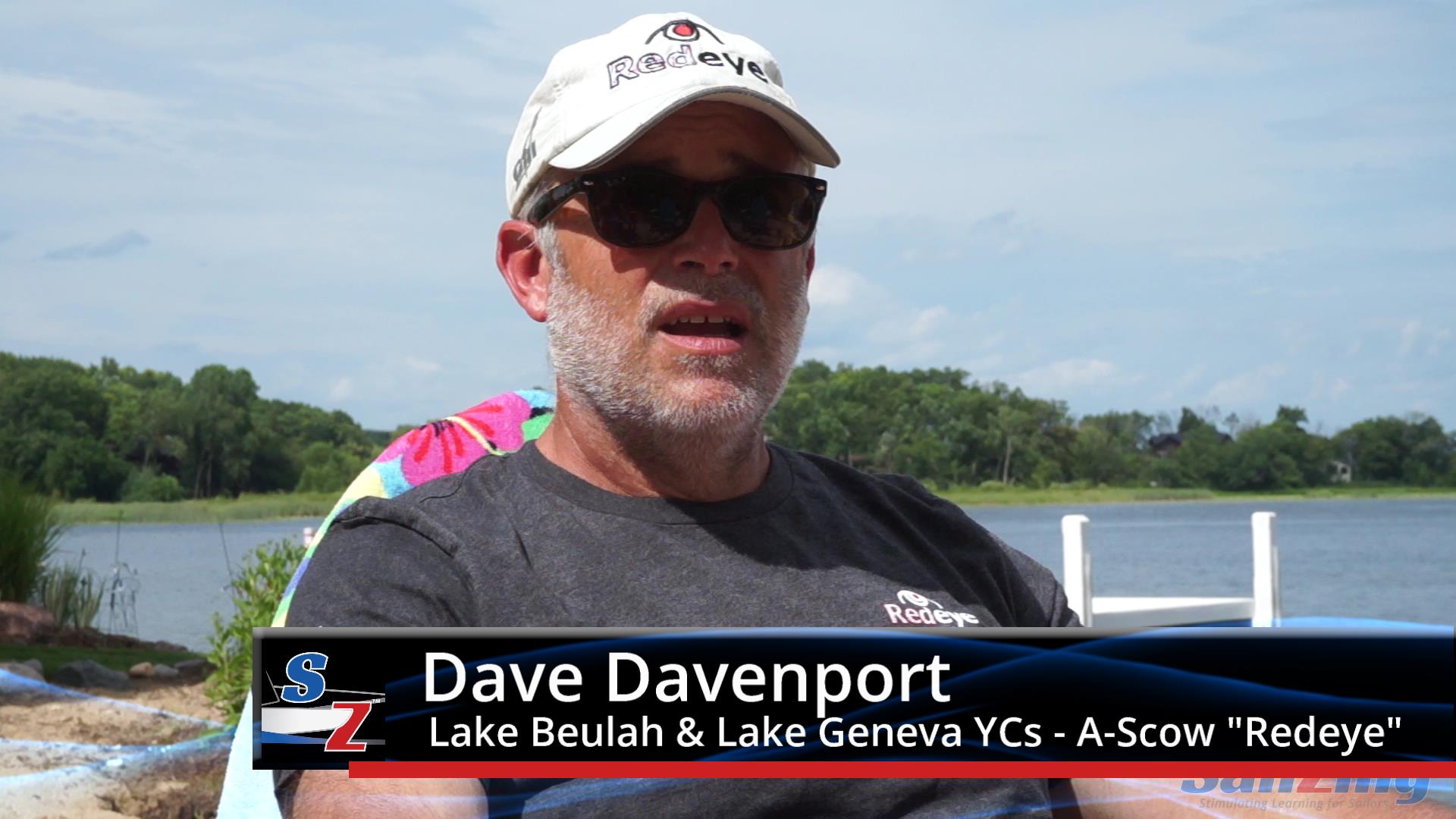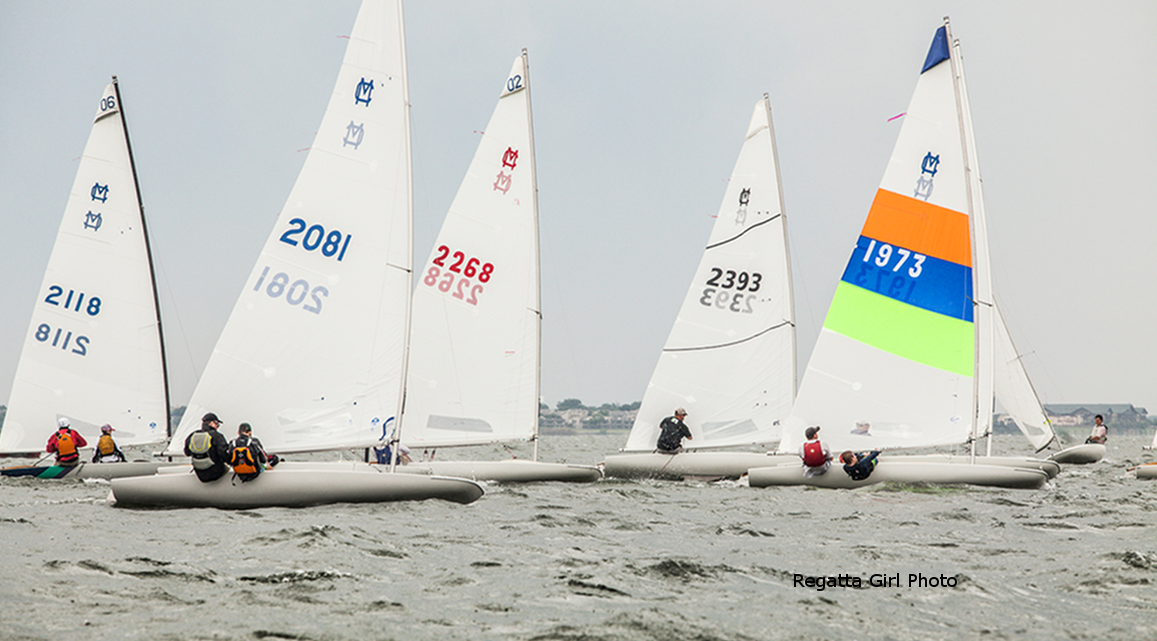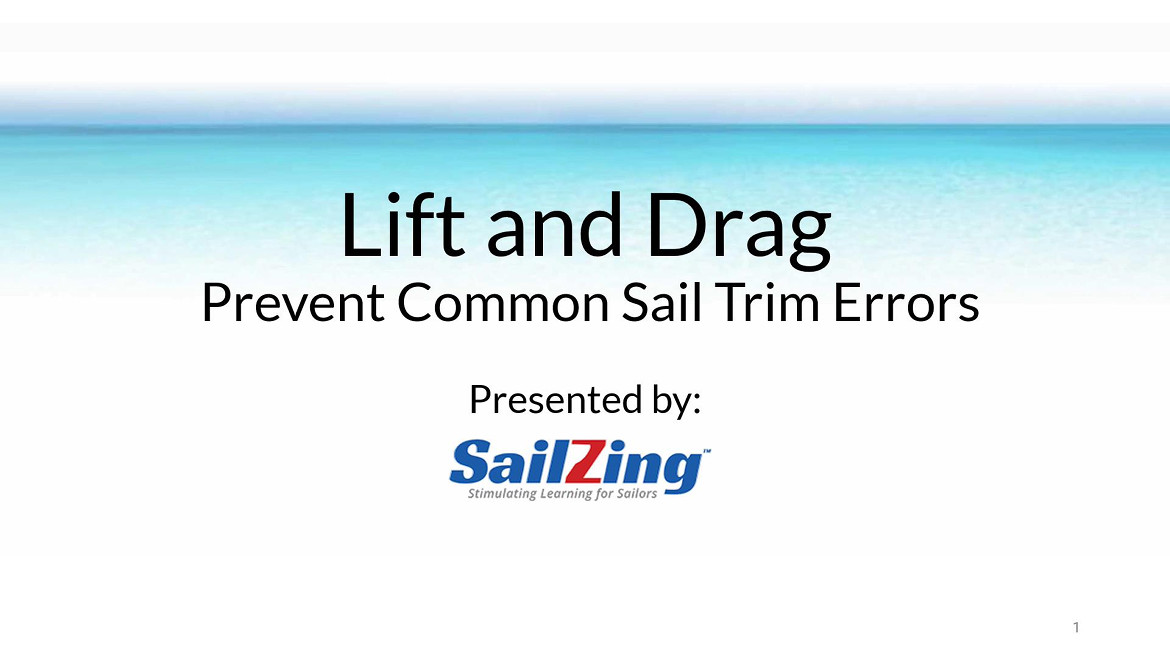Welcome to our series on upwind mainsail trim. This article covers Camber, which is Part 2 of a four-part unit on shaping your sails.
In this series, we’re presenting a comprehensive review of basic and advanced mainsail trim concepts. We want the series to be useful and understandable for all levels of sailors.
Our strategy is to start with small bites and build them into a complete picture of sail trim. We’ll use a visual approach, and give you questions to think about during the presentations. We’ll stay practical, using theory only as needed.
Each topic will have a video and outline version.
Special thanks to Will Hendershot, who contributed photos and much wisdom to this article. Other sources include A Manual of Sail Trim, by Stuart Walker, and Illustrated Sail and Rig Tuning, by Ivar Dedham.
Camber Definition

Camber measures the fullness, or depth of the sail. The term refers to the distance from the chord line of the sail to the point of maximum depth. Sailmakers typically measure the ratio between the camber and the chord length, expressed as a percentage.
Examples
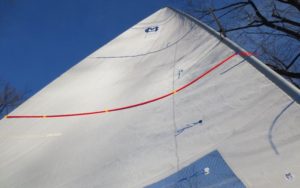
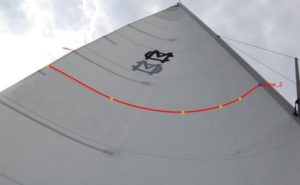
We used online sail measuring software to measure the sails above. The sail on the left has 9.7% camber at its mid-height. On the right is a relatively full sail. Its camber is 16.5% at mid height.
Note that each sail’s camber might be different at different heights.
You can measure your own sail by taking a picture and using one of several available software tools. Here’s a link to the tool from SailPack.
Why Camber is Important
- Camber and angle of attack have the most effect on a sail’s performance
- Increasing a sail’s camber increases both lift and drag
- A fuller sail is not always better.
- If you have adequate lift, focus on reducing drag. See the video for a animated explanation of the effects of drag.
- Makes total force point further forward
- Reduces heeling (side) force
- In light air, too much camber causes flow separation
- Flatter sails aid pointing
- If you have adequate lift, focus on reducing drag. See the video for a animated explanation of the effects of drag.
Managing Camber – Airplanes
Airplane wing design gives us a good example.
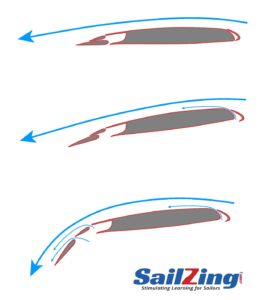
- Takeoff
- Lengthen flaps to increase wing area while it flat to minimize drag
- Cruising
- Retract flaps and keep the win flat low for lowest drag
- Landing
- Lengthen and lower flaps to increase camber and wing area for maximum lift and high drag
Camber and Upwind Performance
Below is a graph showing the upwind performance of two fictional boats one with a 12% mainsail and the other with a 7% mainsail. The bottom axis is wind speed. The vertical axis is velocity made good to windward (VMG).
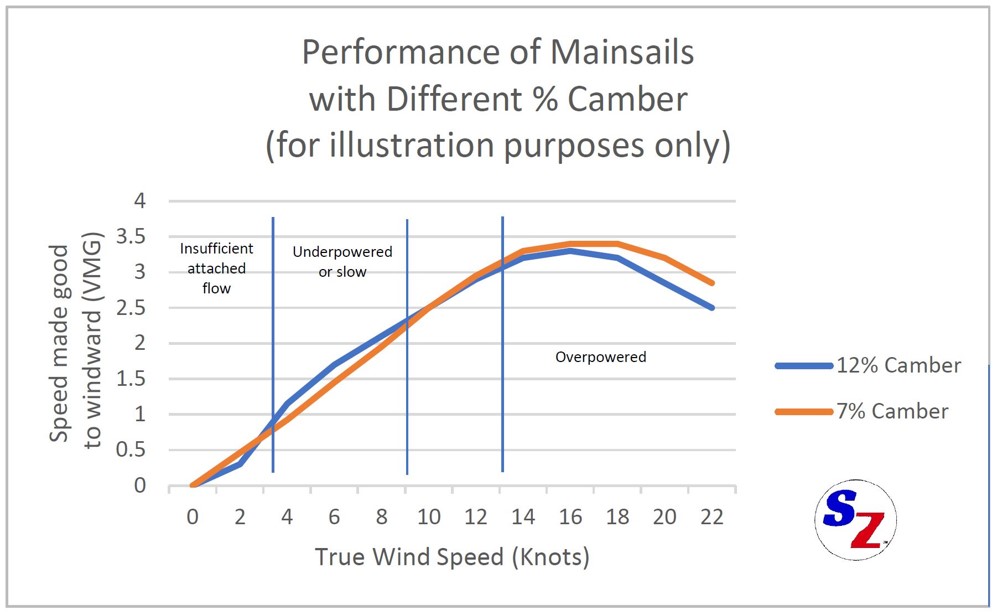
The graph shows four regions based on wind speed.
- Very light air
- Reduce camber to maintain attached flow
- Underpowered or slow
- Increase camber for more lift
- Up to speed
- Reduce camber for less drag and better pointing
- Overpowered
- Reduce camber to minimize drag
- Waves
- Increase camber for more power
How Camber is Built into a Sail
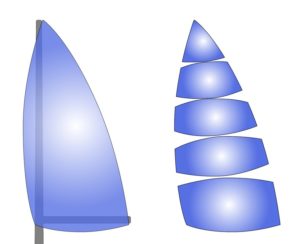
First, the sailmaker cuts the luff and foot of the sail in a curve. This is shown in the left hand diagram. When the boom and mast are straight, the extra material leaves a pocket in the sail. These pockets can be flattened by bending the mast or the boom.
Next, the sailmaker curves the edges of the panels, as shown in the right-hand digram. The picture above is exaggerated to show these curves. When sewn together the extra material forms pockets along the seams. These pockets are less responsive to flattening.
The sail designer determines how much curvature is desired for the luff, foot and each of the seams to optimize the sail shape and its response to the sail controls.
Camber Controls
For this discussion, we’re using a fairly simple fractional rig, with no jib. The mast has one set of stays with swept spreaders. This boat’s controls include a mainsheet, vang, and outhaul.
Mainsheet
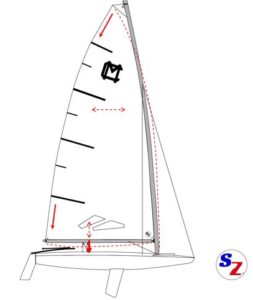
- Pulls end of the boom down to tension leech
- Adds camber to upper sail by closing upper leech
- If mast is flexible, flattens the middle and upper sail by bending mast
- Net effect depends on mast bend and sail design
- Bends boom
- Flattens lower sail (minor effect)
Boom Vang
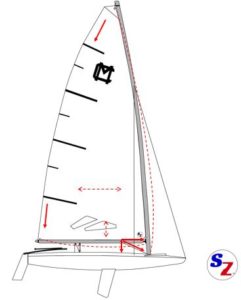
- Pushes lower mast forward
- Flattens lower portion of sail by pulling out the luff curve
- Pulls boom down, aided by mainsheet tension
- May close upper leech to increase camber in top of sail
- May let boom end “float” in gusts if mainsheet is eased
- Bends boom
- Flattens lower sail (minor effect)
- Straightens mast laterally if boom is out
- Reduces camber (minor effect)
Outhaul
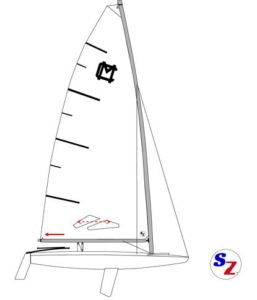
- Adjusts camber in lower part of sail
- Camber in lower sail has both benefits and limitations
- Large area
- Lower portion of the sail contributes least to heeling force
- Some lift is lost when air from the windward side takes a shortcut under the “boom.”
- Causes “upwash” on leeward side
- Limits lift
Indications and Cues
- Draft stripes help you visualize sail shape
- Easy to add with tape from sailmaker supply
- Slight overbend wrinkles indicate that mast bend matches luff curve
- This is desirable, since it shows that the sail shape matches the sailmaker’s design
- Bending mast further has limitations
- May distort shape
- Will not reduce camber that was added by the seams
- May still be effective, but consider other ways of depowering
- Leech telltales indicate condition of flow in aft portion of sail
- Constantly flowing
- Not enough camber in aft portion
- May be underpowered
- Never flowing
- Too much camber in aft portion. OR
- Wind speed too low to maintain attached flow
- Use mainsheet to correct issues with upper leech flows
- Should stall ~50% of the time in light-medium air
- Use outhaul to correct issues with lower leech flows
- May be able to relax outhaul and still maintain flow
- Constantly flowing
Interactions and Challenges
- Upper mainsail camber control needs the most attention
- Must adapt to conditions
- Light air: power up top of main, without stalling
- Heavy air; depower top of main and reduce weather helm
- Rapid changes (gusts, waves): power up and depower without trim inputs (ideal)
- Control is indirect and depends on many factors
- Controls available (e.g., backstays, mainsheet, vang)
- Mast flexibility and rig tuning
- Sail design
- Study your mainsail to understand how it behaves!
- Must adapt to conditions
Heavy Air Boat Speed: Sheet Hard and Drop the Traveler
Light Air Boat Speed: Focus on Flow
Lift and Drag – Prevent Common Sail Trim Errors
Velocity Made Good (VMG) – Definition and Application
Shaping your Sail, Part 1 – Angle of Attack
Shaping Your Mainsail, Part 3 – Draft Shape and Position
Shaping Your Mainsail, Part 4 – Controlling Twist

